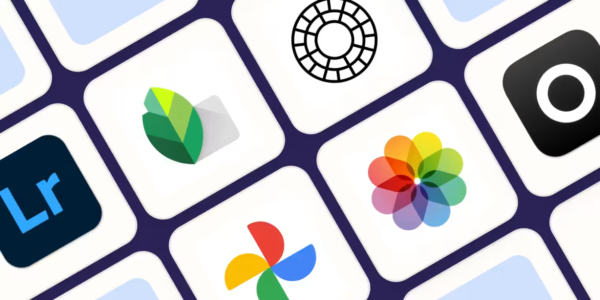Hey there! Ready to take your photos from ordinary to extraordinary? Well, you're in luck because we're diving into the world of popular photo editing apps! Whether you're a selfie pro, a scenic snapshot enthusiast, or just love adding a little flair to your pics, these apps are your ticket to picture-perfect perfection. Get ready to unleash your creativity, tweak those colors, add funky filters, and turn your shots into works of art. With a bunch of cool features and easy-to-use interfaces, these apps make editing fun and hassle-free. So, grab your phone, and let's get snapping and editing – your Instagram feed will thank you later!

1. Adobe Photoshop Lightroom
The industry-standard photo-editing software is Adobe Photoshop Lightroom, available for iOS and Android phones. It's designed for amateur and expert photographers, but it works perfectly for editing any photo you take with your smartphone.
Surprisingly easy to use, Lightroom is a very feature-rich app. However, you can use it to sort and organize your photos (or back them up to Adobe's cloud storage).
Curves and the option to create presets are just two of the many free basic tools you get when editing your photos. Everything is adjustable, including exposure, color, contrast, and cropping.
Lightroom Premium includes additional presets, a potent healing tool, and local edits and masking. It can be purchased separately or as part of several Creative Cloud subscriptions, including desktop versions of Lightroom, Adobe Photoshop, and varied amounts of cloud storage.
2. PicsArt
Among the most popular photo editing apps is PicsArt since it's entertaining, user-friendly, and provides about everything a consumer photographer may need for their mobile device. It offers a wide range of eye-catching filters, excellent image-editing capabilities, and ample creative power. You may also rapidly choose or make amusing stickers, combine your photos to create highly customizable collages, add creative text, and share. Pre-capture effects and photo tools are part of the fully functional camera module.
Remix Chat lets you share and alter photographs with friends or the 150 million monthly PicsArt users in real time. Users can submit their creations based on a theme or a specific sort of modification through challenges in the app, which are straightforward to follow. The community votes to choose the winners.
For casual photographers, PicsArt provides a vast array of easily accessible photo-editing and collage capabilities. And it maintains a dynamic and enjoyable atmosphere while offering plenty of creative freedom.
3. Prisma Photo Editor
Prisma keeps expanding after taking home the 2016 App Store App of the Year award. This is why it’s on our list of most popular photo editing apps. At its basis, Prisma is an artistic and photo-editing program that transforms your finest images into chic paintings. The software offers a constantly growing collection of filters called “styles.”
Prisma applies the chosen style to your photo using artificial intelligence (AI) technology. After that, you can make any necessary adjustments and changes to the finished picture. A comprehensive set of editing options is available here. Sliders on it allow you to change the exposure, sharpness, and saturation.
Although it's not intended for picture editing alone, it does include the necessary features.
There is a fantastic variety of art styles and filter types. Because Prisma publishes a new filter every day, the collection is constantly expanding. It might get addictive to choose and try out new styles. Fundamentally, this software is ideal for enjoying yourself with your photos.
Prisma has amassed a genuine community around the app with over 120 million users. On social media, you may showcase your works of art and view the greatest pictures taken by others. It's even possible to follow and communicate with others.
4. Capture One Pro
Capture One Pro is nearly identical to Adobe Lightroom Classic, with cataloging features, seamless raw processing, manual picture-enhancing tools, preset effects, and a non-destructive workflow that allows you to revisit your modifications anytime. It’s among the popular photo editing apps available.
Compared to Adobe, its raw conversions are more precise and quieter, but it doesn't support as many lens correction profiles or different camera raw formats. Professional-grade “tethering” facilities are available for studio photographers using a computer to capture photographs; however, it lacks Adobe's internet synchronization features and mobile apps.
More than 450 camera models are supported. However, only Sony, Canon, Nikon, and Phase One cameras can be used with tethered capture.
Making local edits with adjustment layers and masks is another improved feature of Capture One Pro. Although pricey, it is excellent.
5. Snapseed
One of the first excellent mobile photo editing apps was called Snapseed. Because of its exceptional quality, Google purchased it to access the development team and technology. Even though Snapseed is not a top Google focus, it's still a powerful and cost-free mobile picture editing tool. It’s also among the most popular photo editing apps.
Snapseed has all the essential tools, some good filters, and an excellent selective adjustment method. These are called U Points, and with a few fast touches, you may change the brightness and color levels of various regions in your image.
These local tweaks are typically only available with subscription plans, so even though Snapseed's user interface hasn't been updated in a while, it's still an appealing option with a slightly easier learning curve than Lightroom.
This software isn't ideal if you want every photo on your social media sites to have a particular style. Otherwise, you can't go wrong if you want a free, capable, and user-friendly mobile image editor.
6. Pixlr
One of the greatest picture editing applications is Pixlr, which is ideal for amateur photographers who want to tweak their images a little, maybe add some interesting effects, and then post the results to their phone's social media accounts. You may immediately start enjoying yourself while experimenting with your photos because the interface is simple to learn and use.
Pixlr offers a good selection of user-friendly photo modification options without becoming overly overwhelming. Brushes for selective editing (such as darkening or undoing) are part of this. The overlays, borders, and special effect filter libraries are entertaining and visually appealing overall. The colorful stickers have a good variety. Make collages quickly with pre-designed templates or preset layouts that let you arrange your photographs randomly.
The app's simple creativity will appeal to casual users, but professional photographers may find Pixlr's editing toolkit too limited.
7. TouchRetouch
TouchRetouch provides an experience that is much more personalized and focused. No wonder it’s on the list most popular photo editing apps. It is an exception when compared to other smartphone editing apps. Unlike most iPhone and Android photo apps, this app concentrates on healing and offers a wide range of editing options.
It's simple to utilize the software itself. It provides every tool needed to eliminate extraneous objects from your images. TouchRetouch doesn't make things too complicated. With TouchRetouch, all it takes is a single finger tap to remove undesirable things.
The auto features of the software allow you to make quick edits, such as eliminating power lines or repairing flaws in portrait photos. Get more hands-on if that's how you prefer to work. The fact that TouchRetouch removes the need for accuracy is its actual advantage.
Simply highlight a portion of the error, and the program will cover the remainder!
Most other mobile editing apps provide image repair or healing in one way or another. That's an essential feature of the majority of well-known photo editing programs. TouchRetouch, however, provides something more sophisticated and potent. The software offers you greater functionality than others by concentrating on this particular editing area.
There are lots of excellent help options available within the program. To aid in your learning as you go, the app even offers courses for you to see.
8. Affinity Photo
Serif Affinity Photo is a fantastic picture editor and compositor that is compatible with Mac and PC platforms. It’s among the most popular photo editing apps.
It is obviously made with the prosumer or professional in mind, and it is loaded with features that would rival those of its greatest rivals, such as Photoshop. Since there are so many tools, we won't even attempt to list them all, but taking advantage of the 10-day free trial to learn about and check them all for yourself is worthwhile.
If you're used to this software, you'll feel perfectly at home with Affinity Photo. The UI is simple and elegant, if a bit too colorful sometimes, and using popup windows to access some parameters is annoying.
Before this, we were worried about the picture editor's lack of updates. That all changed with the recent release of a significant update that includes many helpful tools for designers, photographers, artists, and content producers.
The best part is that it's a one-time purchase with fantastic pricing that provides true value for the money. There are no subscriptions available here. Don't be afraid to use its free 10-day trial period to give it a try.
9. VSCO
Although extensively filtered images became famous on Instagram, and this trend peaked in the mid-2010s, filters are still an excellent method to give photos a consistent, unified aesthetic. It’s among the most popular photo editing apps.
The team behind VSCO first developed Lightroom presets that mimicked film stock. Later, they used this expertise to create a potent, filter-forward picture editor. In contrast to many filter-based applications, every one of VSCO's hundreds of presets feels thoughtful, and the company blog details the thinking process that went into creating them. The filters are also shrewdly arranged into packs of related settings with similar names. For instance, the eight color grade presets have the designations CG1 through CG8, while the popular film stock Kodak Portra is emulated in various ways by KP1 through KP9.
While not all presets will work with every image, it's simple to identify (and save) your favorites or use VSCO's suggestions. Apart from filter functionality, VSCO offers all the standard image editing features you could want, along with some pro tricks like split toning, which allows you to add distinct colors to the highlights and shadows of your image, and dodging and burning, which will enable you to brighten or darken certain regions of your image selectively. You can add other effects, such as film borders, scratches, and grain patterns. Additionally, you can store recipes depending on additional modifications and filter combinations.
10. Google Photos
In our opinion, only one photo app—Google Photos—is essential for any mobile device. It’s among the most popular photo editing apps. You can appreciate why if you have ever experienced the loss of all your media files due to a phone malfunction or loss. Google Photos is a photo and video organiser, shared with ease, and, most crucially, it automatically backs up your whole image library to the cloud, even though it has very few editing options. All your devices loaded with the app will sync with it without problems. This encompasses Windows computers, all Android devices, Apple phones, laptops, tablets, and desktop PCs.
Because they are meant to need minimal user input, Google's photo-editing functions are easy to use and rapid. For example, you can only modify the entire image's color, light, and contrast (pop) using user-controlled sliders. Additionally, a slider to adjust the effect's strength is included with a few filters.
11. Afterlight Photo
Afterlight provides an exceptional harmony between accuracy and ease of use. The program has excellent editing features, including touch tools. These make it possible to edit more precisely. You may change the saturation, hue, color, and much more.
The app has a growing number of preset filters. The filter collection includes mobile guest photographers as well as a variety of themes.
Another bonus is that the software supports RAW images and includes additional capabilities. These include film grain, double exposure, and light leak editing tools.
The app is easy to use and covers all the fundamentals. One significant benefit of the program is how it imports your photo library. Afterlight is a must-have for any mobile user because of its straightforward design and enormous potential.
12. Luminar AI
This is also among the most popular photo editing apps. Luminar AI bridges the gap between entry-level image editors and high-end applications like Photoshop by utilizing artificial intelligence to provide high-quality adjustments rapidly through an intuitive interface. Are you unaware of the color correction based on your curves? Luminar AI will automatically apply the necessary correction when you point it at a specific image. Luminar AI can also assist you in selectively sharpening important areas, adding a new sky, and removing imperfections from your skin if you already know how you want the picture to look.
The whole procedure revolves around two main components: Edits, where effects are applied automatically, and Templates, which provide one-click adjustments to enhance your shot instantly. Try it with a few shots, and without a lengthy editing session, you should get results similar to what an expert would achieve. In essence, tools are essential yet strong.
However, because the complexity lies below the surface, you won't pick up the skills necessary to master image editing. Additionally, several overlay techniques result in repeating images, and performance can be slow while accessing images. In any case, Luminar AI is a novel image editor that is ideal for photographers who prefer to take their time editing photos.
13. Lensa
While most apps on our list make use of AI in some form, few rely on it as much as Lensa does, and not just because of its well-known Magic Avatar function, which uses a large number of selfies to train a Stable Diffusion model to produce a large number of AI portraits. It’s also among the most popular photo editing apps.
Lensa knows when you add an image, whether a landscape, a portrait, or something else. If it's a portrait, you're given a series of tools to adjust things like the glow in your cheeks and the texture of your skin; if it's a landscape, you receive another set of tools to replace the sky with a more dramatic one.
Lensa has an exemplary implementation as far as these kinds of tools go. They can produce excellent results if used sparingly, but overuse usually leads to highly fake photographs.
Lensa provides nearly the same editing options as Lightroom, including the ability to delete things using an AI-powered magic eraser and build masks for localized modifications. It's an excellent picture editor, even with one or two odd AI-powered art filters and the like.
14. Face Tune 2
For retouching portraits, Facetune 2 continues to be the greatest picture editing app. It uses AI to do more than just whiten teeth and smooth skin. Take its cosmetics tools, which create subtle color contours, highlights, and shadows. The ability to transform a somber expression into a more endearing smiling photo is something you will enjoy. The effects can be made more intense or less intense using the straightforward slider settings. Before taking the photo, you can adjust your portrait in the camera's preview.
Sadly, some of the most intriguing features of the software are unavailable to you if you don't purchase the premium edition. These include altering the sky, background, or eye color, eliminating imperfections, or applying touch-up techniques (e.g., adjusting the eyebrows or reducing bags under the eyes).
Conclusion
Many popular photo editing apps enhance the world of photography, offering users powerful tools to unleash their creativity and refine their images with ease and precision.















